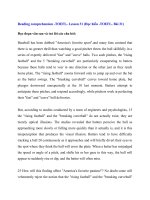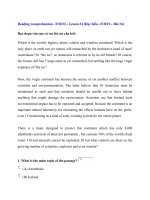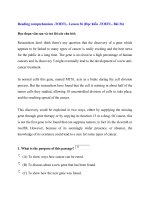Đọc hiểu -TOEFL- Bài 4 pot
Bạn đang xem bản rút gọn của tài liệu. Xem và tải ngay bản đầy đủ của tài liệu tại đây (77.92 KB, 7 trang )
Reading comprehension -TOEFL- Lesson 4 (Đọc hiểu -TOEFL- Bài 4)
Đọc đoạn văn sau và trả lời các câu hỏi:
A pilot cannot fly a plane by sight alone. In many conditions, such as flying at
night and landing in dense fog, a pilot must use radar, an alternative way of
navigating. Since human eyes are not very good at determining speeds of
approaching objects, radar can show a pilot 5 how fast nearby planes are moving.
The basic principle of radar is exemplified by what happens when one shouts in a
cave. The echo of the sounds against the walls helps a person determine the size of
the cave. With radar, however, the 10 waves are radio waves instead of sound
waves. Radio waves travel at the speed of light, about 300,000 kilometers in one
second. A radar set sends out a short burst of radiation waves. Then it receives the
echoes produced when the waves bounce off objects. By determining the time it
takes for the echoes to return to the radar set, a trained 15 technician can determine
the distance between the radar set and other objects. The word "radar," in fact, gets
its name from the term "radio detection and ranging." "Ranging" is the term for
detection of the distance between an object and the radar set. Besides being of
critical importance to pilots, radar is essential for air traffic control, 20 tracking
ships at sea, and for tracking weather systems and storms.
1. What is the main topic of this passage?
(A) the nature of radar
A
(B) types of ranging
(C) alternatives to radar
(D) history of radar
2. In line 2, the word "dense" could be replaced by
(A) cold
(B) wet
(C) dark
(D) thick
3. According to the passage, what can radar detect besides location of objects?
(A) size
D
C
(B) weight
(C) speed
(D) shape
4. The word "shouts" in line 8 is most similar in meaning to which of the
following?
(A) eavesdrops
(B) yells
(C) confesses
(D) whispers
5. Which of the following words best describes the tone of this passage?
(A) argumentative
B
C
(B) imaginative
(C) explanatory
(D) humorous
6. The phrase "a burst" in line 13 is closest in meaning in which of the
following?
(A) an attachment
(B) a discharge
(C) a stream
(D) a ray
7. The word "it" in line 13 refers to which of the following?
(A) a radar set
B
A
(B) a short burst
(C) a radiation wave
(D) light
8. Which of the following could best replace the word "bounce" in line 13?
(A) overturn
(B) groove
(C) extend
(D) rebound
9. Which type of waves does radar use?
(A) sound
D
C
(B) heat
(C) radio
(D) light
10. The word "tracking" in line 20 is closest in meaning to which of the
following?
(A) repairing
(B) searching for
(C) glancing at
(D) fighting
11. Which of the following would most likely be the topic of the next
paragraph?
B
A
(A) other uses of radar
(B) uses of sonar technology
(C) other technology used by pilots
(D) a history of flying
12. What might be inferred about radar?
(A) It takes the place of a radio.
(B) It gave birth to the invention of the airplane.
(C) It developed from a study of sound waves.
(D) It has improved navigational safety.
D









